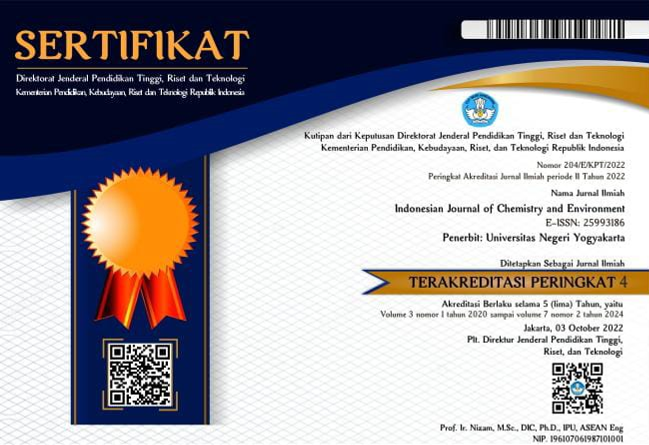Fatliquor Development from Hemp Oil to Produce High Quality Natural Finished Leather
DOI:
https://doi.org/10.21831/ijoce.v5i1.51418Abstract
References
Ashebre, M. (2014). Performance of leather uppers of local footwear products and the determinants. Internafional: ournal of Advancements in Research & Technology, 3(3), 26-30. The Biology of Cannabis sativa L. (Cannabis, hemp, marijuana). Retrieved 1-6-2022 from https://inspection.canada.ca/plant-varieties
Borhade, S. S. (2013). Chemical Composition and Characterization of Hemp (Cannabis sativa) Seed oil and essential fatty acids by HPLC Method. Archives of applied science research, 5(1), 5-8.
Hodgson, E. (2012). Toxins and venoms. Progress in molecular biology and translational science, 112, 373-415.
IULTCS. (2011). Determination of Tensile Strength and Percentage Elongation (ISO 3376). In Leather "” Physical and mechanical tests. Muttenz, Switzerland: International Union of Leather Technologists and Chemists Societies.
IULTCS. (2015a). Determination of Distension and Strength of Surface (Ball burst method), (ISO 3379). In Leather (pp. 5). Muttenz, Switzerland: International Union of Leather Technologists and Chemists Societies.
IULTCS. (2015b). Determination of Softness (ISO 17235). In Leather "” Physical and mechanical tests (pp. 4). Muttenz, Switzerland: International Union of Leather Technologists and Chemists Societies.
IULTCS. (2016). Determination of Tear Strength (ISO 3377-2). In Leather "” Physical and mechanical tests (pp. 3). Muttenz, Switzerland: International Union of Leather Technologists and Chemists Societies.
IULTCS. (2018). Determination of Formaldehyde Content in Leather
Part 2: Quantification by Colorimetric Analysis (EN ISO 17226-2). In Leather. Muttenz, Switzerland: International Union of Leather Technologists and Chemists Societies.
Joore, L. H. M. V. D. H. a. I. L. P. A. A. (1991). Elementary Practical Chemical Leather Analysis. TNO.
Liang, J., Appukuttan Aachary, A., & Thiyam"Holländer, U. (2015). Hemp seed oil: Minor components and oil quality. Lipid Technology, 27(10), 231-233.
Mí¶llenken, H. (1998). Transfatty acids in heated hemp seed oil. J Int Hemp Assoc, 5, 21-25.
Oomah, B. D., Busson, M., Godfrey, D. V., & Drover, J. C. (2002). Characteristics of hemp (Cannabis sativa L.) seed oil. Food chemistry, 76(1), 33-43.
Pervez, M., Ahmed, F., Mahboob, S., Dewani, R., Nawaz, H., Zeeshan, M., & Ayaz, T. (2015). Synthesis of biological based anionic fatliquor and its application on leather. Journal of the American Leather Chemists Association, 110(10), 326-331.
Poisa, L., & Adamovics, A. (2010). Hemp (Cannabis sativa L.) as an environmentally friendly energy plant. Rigas Tehniskas Universitates Zinatniskie Raksti, 5, 80.
SLTC. (1996). Determination of pH (SLC 308) In Official Method of Analysis. Northampton, UK: Society of Leather Technologists and Chemists.
SLTC. (1996a). Determination of Total Fat (SLC 319) In Official Method of Analysis. Northampton, UK: Society of Leather Technologists and Chemists.
SLTC. (1996b). Determination of Water Content (SLC 307) In Official Method of Analysis. Northampton, UK: Society of Leather Technologists and Chemists.
SLTC. (1996c). Determination of Saponification Value (SLC 303) In Official Method of Analysis. Northampton, UK: Society of Leather Technologists and Chemists.
SLTC. (1996d). Determination of Acid Value (SLC 304) In Official Method of Analysis. Northampton, UK: Society of Leather Technologists and Chemists.
SLTC. (1996e). Determination of Iodine Value (SLC 305) In Official Method of Analysis. Northampton, UK: Society of Leather Technologists and Chemists.
SLTC. (1996f). Determination of Alkalinity (SLC 312) In Official Method of Analysis. Northampton, UK: Society of Leather Technologists and Chemists.
SLTC. (1996g). Determination of pH (SLC 120) In Official Method of Analysis. Northampton, UK: Society of Leather Technologists and Chemists.
SLTC. (1996h). Determination of pH Value and Difference Figure of an Aqueous Extract (SLC 13). In Official Method of Analysis. Northampton, UK: Society of Leather Technologists and Chemists.
SLTC. (2005a). Determination of Iodine Value (SLO 1/6). In Official Method of Analysis. Northampton, UK: Society of Leather Technologists and Chemists.
SLTC. (2005b). Determination of Volatile Matter (IUC 5). In Official Method of Analysis (pp. 4). Northampton, UK: Society of Leather Technologists and Chemists.
SLTC. (2017). Chemical determination of Chromium(VI) Content in Leather "” Part 1: Colorimetric method (ISO 17075-1). In Leather (pp. 1-11). Muttenz, Switzerland: IULTCS.
SLTC. (2018). Determination of Matter Soluble in Dichloromethane and Free Fatty Acid Content (IUC 4). In Official Method of Analysis (pp. 8). Northampton, UK: Society of Leather Technologists and Chemists.
Sova, N., Lutsenko, M., Korchmaryova, A., & Andrusevych, K. (2018). "Research of Physical and Chemical Parameters of the Oil obtained from Organic and Conversion Hemp Seeds Varieties Hliana". Ukrainian food journal, (7, Issue 2), 244-552.
Downloads
Published
How to Cite
Issue
Section
Citation Check
License
Authors who publish with this journal agree to the following terms:
- Authors retain copyright under a Creative Commons Attribution–ShareAlike License (CC BY SA) that allows others to share: copy, and redistribute the material in any medium or format, Adapt: remix, transform, and build upon the material, for any purpose, even commercially.
- Authors are able to enter into separate, additional contractual arrangements for the non-exclusive distribution of the journal's published version of the work (e.g., post it to an institutional repository or publish it in a book), with an acknowledgement of its initial publication in this journal.
- Authors are permitted and encouraged to post their work online (e.g., in institutional repositories or on their website) prior to and during the submission process, as it can lead to productive exchanges, as well as earlier and greater citation of published work.










